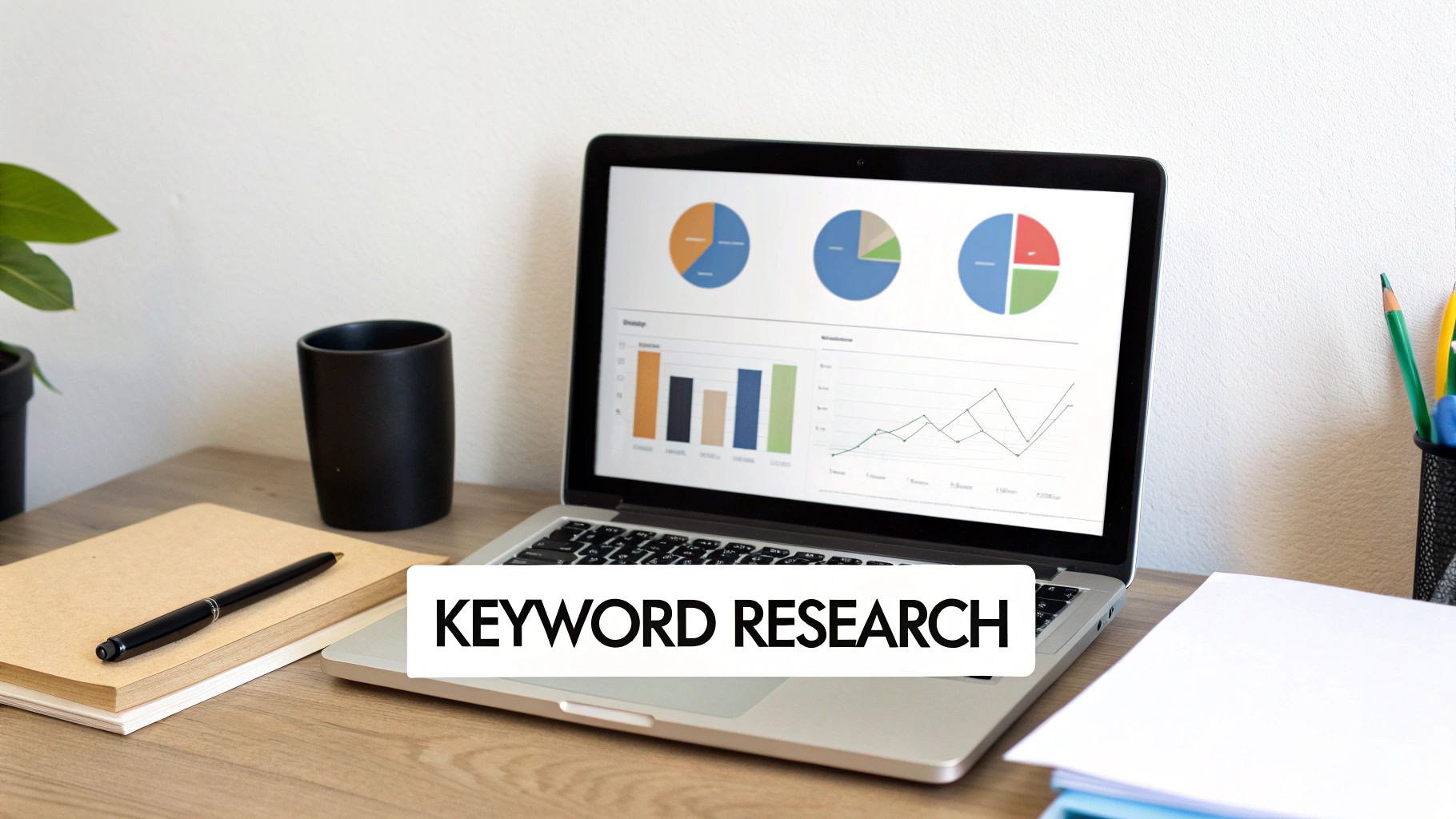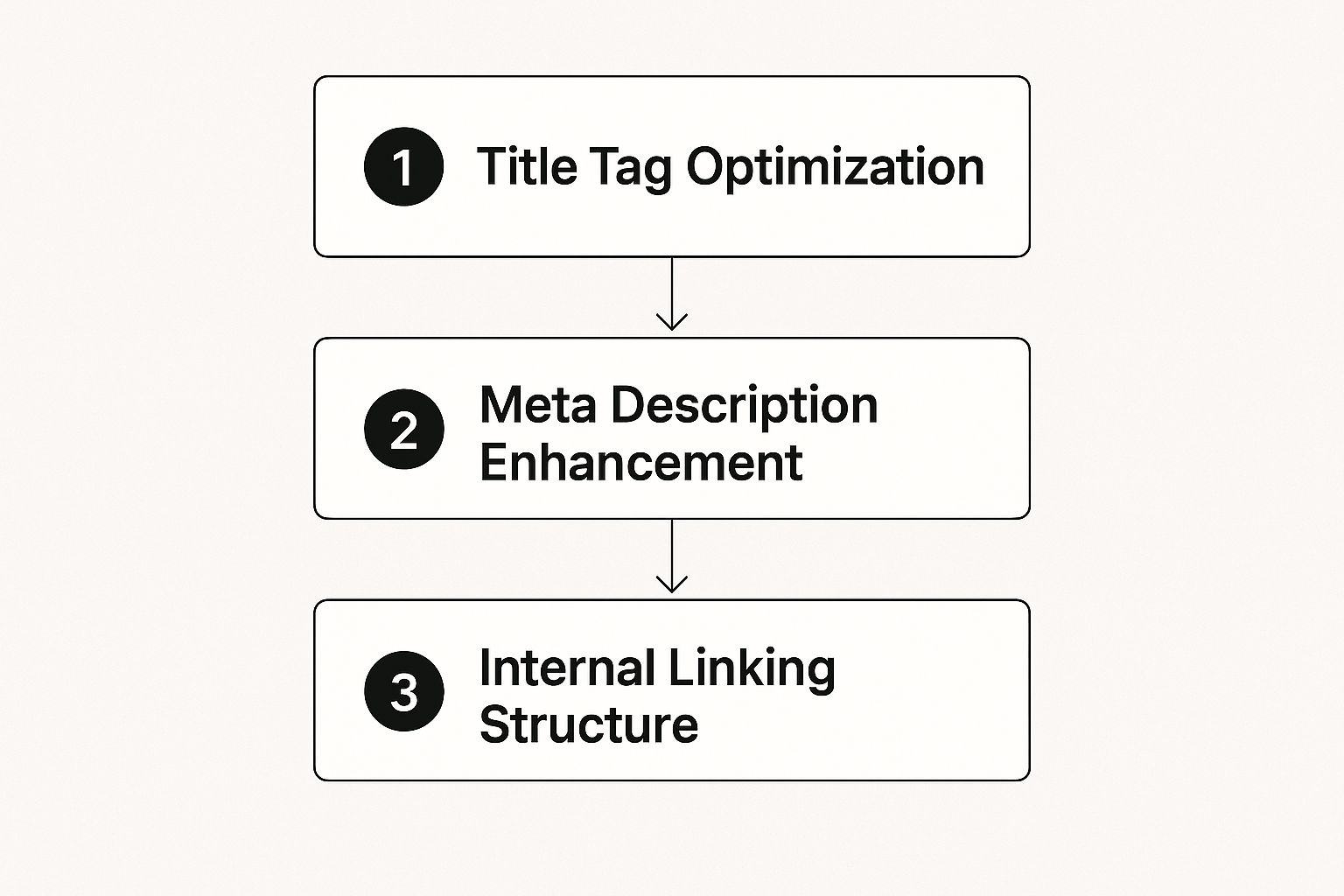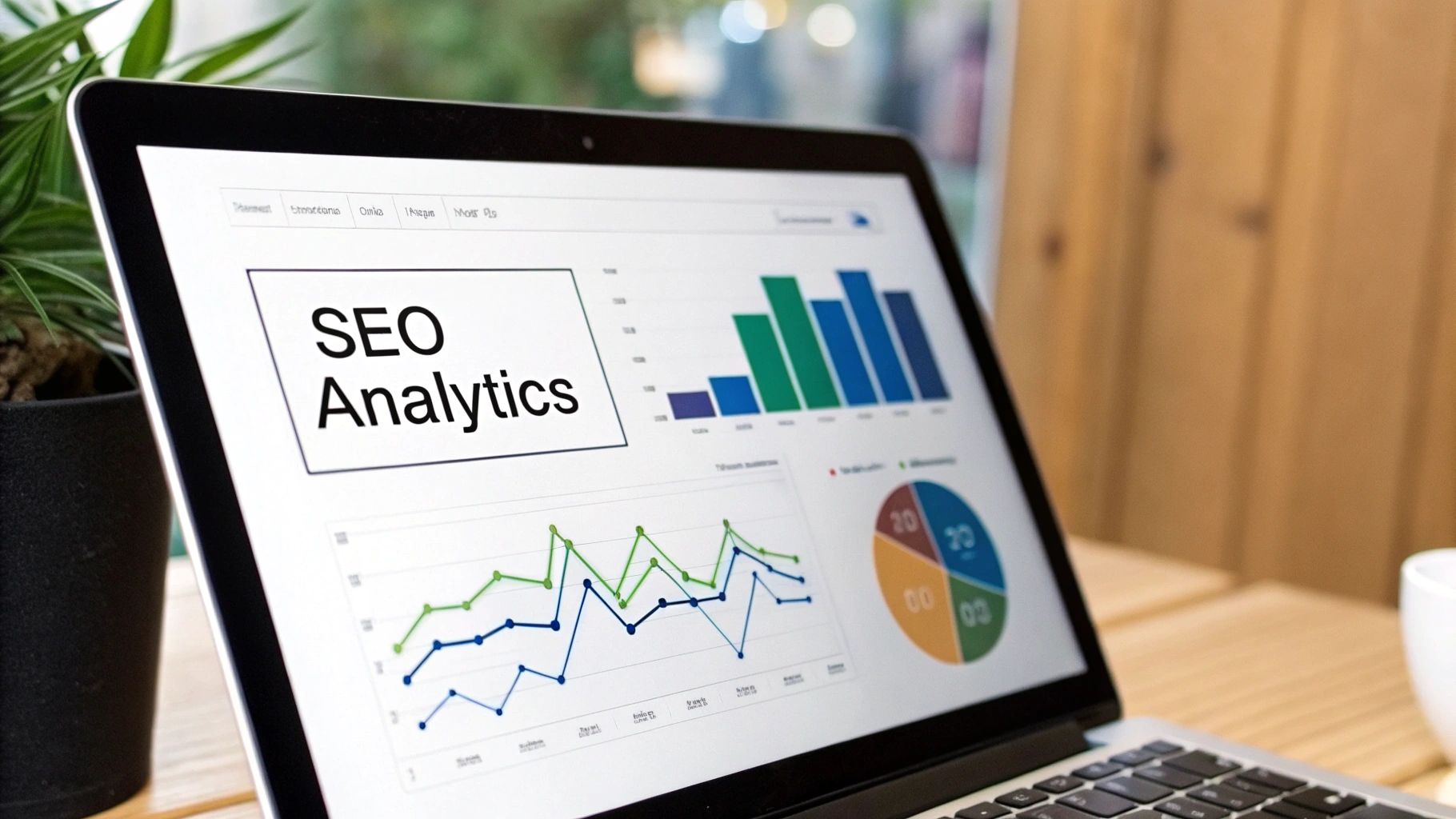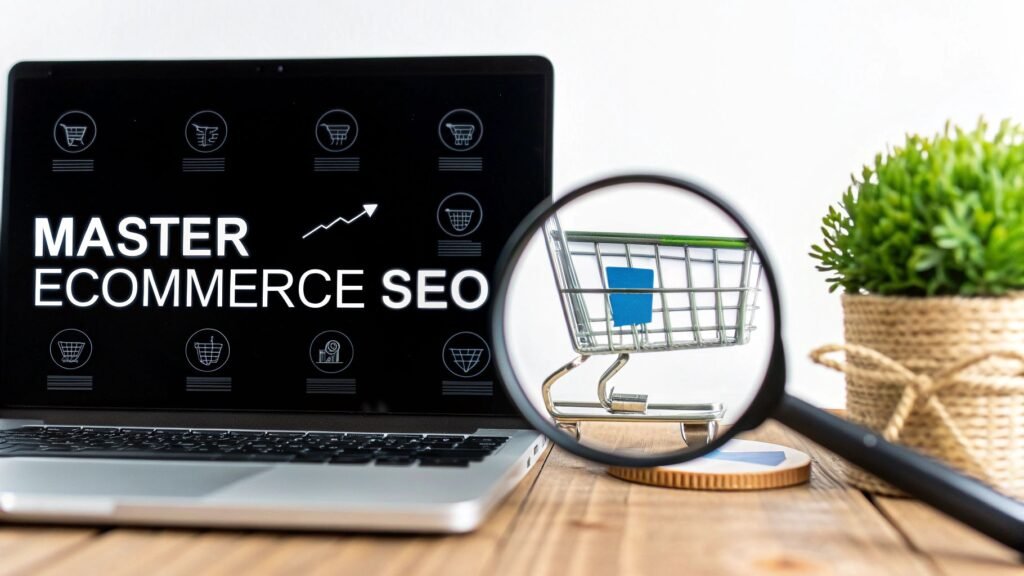Ecommerce SEO marketing is all about making your online store more visible on search engines like Google. The goal? To get in front of customers who are already looking for the exact products you sell. It’s a powerful, long-term strategy that drives organic traffic—which means you don’t pay for every single click—by fine-tuning your website's technical setup, on-page content, and off-page authority.
Why SEO Is Your Store’s Most Valuable Asset
Imagine you’ve built a brilliant retail store, but it’s located on a street with zero foot traffic. That’s pretty much what running an online store without a solid ecommerce SEO marketing strategy feels like. Sure, paid ads can give you a temporary burst of visitors, but SEO builds a permanent superhighway of motivated buyers directly to your digital doorstep. It delivers sustainable growth that actually compounds over time.

This guide is your roadmap to moving your store from that quiet back alley to a prime digital location. Unlike fleeting social media trends or expensive ad campaigns that stop the moment you stop paying, a well-executed SEO plan becomes a permanent asset for your business. Think of it as building a powerful engine that works for you 24/7, turning your online shop from a hidden gem into a bustling marketplace.
The Growing Importance of Online Visibility
The shift to online shopping isn’t just a passing trend; it's a fundamental change in how people buy things. In Australia, this transformation has been especially dramatic. Post-pandemic, Aussies spent a record-breaking $69 billion online, a figure that’s nearly doubled since 2019.
With e-commerce now making up almost 20% of total retail spending, having a strong digital presence is no longer optional. To tap into this thriving market where over 83% of shoppers purchase online every month, a targeted SEO strategy is crucial.
For Journalists (Reddit-worthy take): Paid ads are like renting a billboard on a highway. The traffic stops the second you stop paying. SEO is like owning the exit ramp directly to your storefront. It's a permanent asset that continuously channels customers your way, long after the ad budget runs out.
Core Pillars of Ecommerce SEO Success
A successful ecommerce strategy is built on several key foundations that all work together. It's vital to understand the importance of an SEO strategy for every business to really grasp its full potential. Your efforts will ultimately centre on:
- Technical Excellence: Making sure your site is fast, secure, and dead simple for search engines to crawl and understand.
- On-Page Optimisation: Crafting product and category pages that perfectly match what your customers are searching for.
- Off-Page Authority: Building trust and credibility through high-quality backlinks and positive brand mentions across the web.
- Strategic Content: Creating genuinely helpful content that answers customer questions and establishes you as an expert in your field.
By mastering these elements, you create a powerful system for attracting, engaging, and converting customers. For a deeper dive into the fundamentals, check out our guide on what is search engine optimisation.
Building a Bulletproof Technical SEO Foundation
Before you even think about dazzling customers with your products, your website has to impress an entirely different audience: search engines. This is the bedrock of your ecommerce SEO marketing, known as technical SEO.
Think of it as your store’s invisible infrastructure—the plumbing, wiring, and floor plan. If that foundation is shaky, everything else you build on top of it is at risk of crumbling. A solid technical setup ensures search engines like Google can easily find, understand, and ultimately trust your site enough to show it to potential customers.
Get this part wrong, and you're in for a world of pain. A slow website will send frustrated shoppers running to your competitors. A confusing site structure means Google’s crawlers might miss your most important pages entirely. Nailing the technical details isn't just a good idea; it's a non-negotiable first step.
Mastering Crawlability and Indexing
For Google to rank your pages, two things have to happen first. It needs to find them (crawlability), and then it needs to add them to its massive digital library (indexing). Your job is to make this process as smooth and efficient as possible.
An online store can easily have thousands of pages. If Google wastes its precious time crawling low-value URLs—like those created by product filters or internal search results—it might give up before it ever reaches the pages that actually make you money.
You can play traffic cop for search engine crawlers using a well-structured robots.txt file and an XML sitemap. Together, they act as a map and a set of rules for your site, telling crawlers exactly which pages to visit and which to ignore. This sharpens their focus, making sure your key product and category pages get the attention they deserve.
For Journalists (Reddit-worthy take): A website's 'crawl budget' is like a journalist's word count. You can't cover every single detail, so you focus on the most important information. Technical SEO is the editor that tells Google, "Ignore the fluff, here's the headline story"—ensuring your best products get the feature, not buried in the footnotes.
Prioritising Site Speed and Mobile Experience
In the world of ecommerce, speed is money. It's that simple. A study by Portent found that conversion rates drop by an average of 4.42% for every extra second a page takes to load. Customers expect a lightning-fast, seamless experience. If your store lags, they’ll be gone before you can say "add to cart."
This need for speed is even more critical on mobile, where most online shopping now takes place. Google uses mobile-first indexing, which means it primarily looks at your mobile site to decide your rankings. A clunky, slow mobile experience doesn't just annoy users; it actively torpedoes your SEO performance.
Getting your site up to speed involves a few key moves:
- Compressing Images: Use modern image formats and compression tools to shrink file sizes without turning your beautiful product photos into pixelated messes.
- Minimising Code: Clean up your website's CSS, JavaScript, and HTML. Every line of unnecessary code is dead weight slowing you down.
- Leveraging Caching: This allows you to store parts of your site so they don’t have to be reloaded every time for returning visitors, drastically cutting down load times.
Here's a quick look at the core technical tasks that make the biggest difference.
Essential Technical SEO Checklist for Online Stores
A focused summary of high-impact technical SEO tasks that directly improve your store's search performance and user experience.
| Technical Element | Why It's Critical | Your First Actionable Step |
|---|---|---|
| Mobile-First Design | With most shoppers on phones, a poor mobile experience is a direct path to lost sales and lower rankings. | Use Google's Mobile-Friendly Test to check your key pages and fix any reported issues. |
| Site Speed | Slow pages kill conversions and hurt your SEO. Every second counts. | Run your homepage and a product page through PageSpeed Insights and tackle the top recommendations. |
| HTTPS Security | Protects customer data and builds trust. It's a non-negotiable for any store that accepts payments. | Confirm your entire site uses HTTPS. If not, install an SSL certificate immediately. |
| Clean URL Structure | Simple, descriptive URLs are easier for both humans and search engines to understand. | Review your product and category URLs. Are they readable (e.g., /mens-shoes/running-sneakers)? |
| XML Sitemap | Acts as a roadmap for search engines, helping them discover all your important pages. | Generate or update your XML sitemap and submit it to Google Search Console. |
robots.txt File |
Tells search engine crawlers which parts of your site to ignore, saving valuable crawl budget. | Check your robots.txt file to ensure you aren't accidentally blocking important pages. |
| No Broken Links | Broken links create a frustrating user experience and signal a poorly maintained site to Google. | Use a free tool like Screaming Frog (free for up to 500 URLs) to crawl your site and find 404 errors. |
Getting these elements right sets the stage for everything that follows. It's the essential groundwork that allows your other SEO efforts to truly shine.
Securing Your Store and Enhancing Listings
Trust is a huge part of closing a sale online. A secure connection, shown by the HTTPS in your URL, is an absolute must-have. It encrypts the data between your customers' browsers and your server, protecting sensitive information like their credit card details. Google sees this as a critical trust signal and even gives a slight ranking boost to secure sites.
But security is just the start. You can make your products stand out right there in the search results using something called structured data, also known as Schema markup. This is a special bit of code that gives search engines extra context about what your content is. For an ecommerce site, this is pure gold.

This graphic illustrates how foundational on-page elements like titles and links rely on a technically sound site to have any real impact. Structured data is the next layer on top of that.
With structured data properly implemented, your search listings can show off eye-catching details like:
- Pricing: Display the cost directly in the search results.
- Availability: Let shoppers know if a product is in stock before they even click.
- Reviews and Ratings: Show off those five-star ratings to build instant social proof.
These enhanced listings, known as "rich snippets," make your products far more attractive and clickable, giving you a serious edge over competitors in a crowded search page.
Winning Customers with On-Page SEO
If technical SEO is the foundation of your store, think of on-page SEO as the fitout. It’s how you arrange your digital shelves, write compelling product signs, and create a shopping experience that turns casual browsers into loyal customers. This is where your ecommerce seo marketing strategy really comes alive.

The goal is pretty straightforward: make sure your product and category pages align with the exact words and phrases real people use when they’re ready to buy. It’s about moving beyond old-school tricks like keyword stuffing and focusing on creating pages that are genuinely helpful and persuasive for both search engines and human shoppers.
Uncovering Buyer Intent with Keyword Research
Before you can touch a single page, you have to get inside your customers' heads and understand the language they use. The bedrock of any solid on-page strategy is comprehensive keyword research that uncovers not just what people search for, but why.
It helps to think of it like this: someone searching for "running shoe technology" is in a completely different headspace than someone searching for "buy nike pegasus 40 size 11." The first search is about information; the second is a clear signal to buy. Your product and category pages absolutely must target these high-intent, transactional keywords to catch shoppers right when they're pulling out their wallets.
The process involves digging up your core product terms, long-tail variations (those super-specific, multi-word phrases), and all the questions your customers might be asking. The right tools and a bit of analysis will give you the precise language you need to weave into your pages to signal relevance to Google.
Crafting Magnetic Titles and Descriptions
In the crowded space of search results, your page's title tag and meta description are your first—and sometimes only—chance to make an impression. They function as a mini-advertisement, fighting for attention against every other listing on the page.
A well-written title is clear, includes the main keyword, and ideally throws in a compelling benefit. A great meta description builds on this, highlighting key features, a unique selling point, or a clear call to action. While the meta description itself isn't a direct ranking factor, a persuasive one can seriously boost your click-through rate, which sends all the right signals back to Google.
For Journalists (Reddit-worthy take): A title tag is the headline of a news article; the meta description is the lede. If the headline doesn't grab attention and the lede doesn't promise value, the reader scrolls past. In search results, a 'scroll past' is a lost customer, and your story—no matter how good—is never read.
Optimising Product and Category Pages
This is where the magic happens. Your product and category pages are where conversions live or die, so they need to be meticulously optimised to guide users toward a purchase.
- Product Pages: These are your digital salespeople. Optimisation here means writing unique, benefit-driven product descriptions—never just copy-pasting from the manufacturer. It means using high-quality images with descriptive alt text and plastering customer reviews everywhere to build social proof. Every single element should answer a question or overcome an objection.
- Category Pages: These are the main aisles of your store. They need a clear, optimised H1 heading and some brief introductory text that helps both users and search engines understand what they're looking at. These pages are often your best shot at ranking for broader, high-volume keywords like "women's winter coats."
The Power of Internal Linking
Finally, internal linking is the secret sauce that ties your entire site together into a logical, cohesive structure. It's simply the act of linking from one page on your site to another, creating pathways that help search engines understand how all your content is related.
For an online store, this is incredibly powerful. You can link from blog posts about "how to choose a running shoe" to your running shoe category, from that category page down to specific products, and even between related products to encourage cross-sells. This strategic linking spreads authority throughout your site, guiding both shoppers and search engine crawlers to your most important, money-making pages and giving them the visibility they need to drive sales.
Earning Trust with Off-Page Authority
Having fantastic products and a perfectly tuned website is a massive win, but it’s only half the battle. Your store also needs a rock-solid reputation out there on the wider web. This is where off-page SEO comes into play—it’s the digital version of powerful, trust-building word-of-mouth.
Off-page signals are how you prove to search engines and customers that your store is the real deal. When other respected websites, blogs, or influencers mention you, it’s a powerful endorsement. These signals build the credibility that’s absolutely essential for any successful ecommerce seo marketing strategy.
Building Relationships, Not Just Links
Let's be honest, "link building" has a bit of a bad reputation. It often brings to mind spammy, technical chores. But modern, effective link building is about something much simpler and more genuine: building real relationships. Every link you get from a reputable site is like a vote of confidence for your brand.
Think about it like this: if a popular industry blog reviews your products and links to your store, they are vouching for you. Google sees this endorsement and gets the message that your site offers real value. These aren't just random links; they are signals of trust that directly boost your authority and, in turn, your search rankings.
For Journalists (Reddit-worthy take): Off-page SEO is like getting your product featured in a major magazine. The article drives immediate interest, but the real power is the credibility it builds. A link from a high-authority website is a permanent "As Seen In" badge that continuously signals trustworthiness to search engines, long after the magazine is recycled.
Creating Assets People Want to Share
The most sustainable way to get high-quality links is to create something so genuinely useful that people are eager to share it. These are called linkable assets. Instead of begging for links, you create content that earns them on its own merit.
For an ecommerce store, this could look like a few different things:
- Definitive Buyer's Guides: An in-depth guide on "How to Choose the Perfect Tent for Australian Conditions" is far more link-worthy than a basic product page.
- Unique Industry Data: If you sell coffee beans, you could survey your customers and publish a report on "Australia's Coffee Drinking Habits." Journalists and bloggers love citing original data like this.
- Helpful Tools: A simple online calculator, like one that helps customers figure out the right size bike frame, can naturally attract links from cycling forums and blogs.
The key is to create resources that serve the community around your niche, not just your immediate customers. This positions you as an expert and makes your site a go-to source of information. For a deeper look into this and other tactics, you can explore some of the most effective off-page SEO strategies that build lasting authority.
The Growing Role of Reviews and Social Buzz
While top-notch backlinks are the cornerstone of off-page authority, they aren't the only thing that matters. The conversations happening about your brand all over the internet also play a huge role.
Positive online reviews on platforms like Google, ProductReview.com.au, and industry-specific sites are powerful trust signals. They show potential customers you follow through on your promises. In the same way, active social media profiles and brand mentions show that you're a legitimate, engaged business.
While these social signals might not be direct ranking factors, they absolutely contribute to your overall brand presence and credibility. All of this indirectly supports your SEO by building a brand that both users and search engines have learned to trust.
Driving Traffic with Content Marketing
While those off-page signals are busy building your reputation, content marketing is how you actively get in front of customers long before they’re even thinking about hitting “add to cart.” It’s the difference between being a helpful expert in the aisle and just being the cashier at the checkout.
Think of it this way: your content is an investment in trust. You’re creating valuable, relevant stuff that solves problems for a specific audience. It's not a direct sales pitch; it’s about answering their questions and guiding them. When they're finally ready to buy, you're the natural choice because you've already proven you know your stuff.
Moving Beyond Product Pages
Your product and category pages are built for one job: closing the deal. They’re laser-focused on shoppers who have their wallets out, ready to go. But what about the huge number of people who are still just browsing, comparing, or figuring out what they even need? That’s where content marketing truly shines.
By creating content that helps them at every step of their journey, you become more than just a store—you become an essential resource. This doesn't just pull in traffic; it builds a loyal community and cements your brand as the go-to authority in your space.
For Journalists (Reddit-worthy take): Content marketing is the ultimate top-of-funnel play. A product page is a sales pitch, designed to close a deal. A blog post is an expert consultation, designed to build trust. One makes a sale today; the other creates a customer for life. The best brands do both.
Types of Content That Drive Sales
Effective ecommerce content isn’t a one-size-fits-all deal. It comes in many forms, each playing a specific role in guiding a customer from curiosity to purchase. The real goal is to build a rich ecosystem of resources around your products, making your site the only place they need to visit.
-
Educational Blog Posts: These are your bread and butter. They tackle the "how-to," "what-is," and "why" questions your potential customers are punching into Google. For a store selling hiking gear, a post like "How to Choose the Right Hiking Boots for Australian Trails" is pure gold for attracting people in that early research phase.
-
In-Depth Buying Guides: People love a good comparison. Detailed guides or "best of" lists are absolute powerhouses for conversions. A comprehensive guide breaking down different types of coffee grinders, complete with pros and cons, helps shoppers make a confident decision and positions you as a knowledgeable expert they can trust.
-
Video Tutorials and Demos: Let's be honest, text and images can only do so much. Video brings your products to life. A quick tutorial showing how to use that fancy kitchen gadget or a demo proving the durability of your outdoor equipment can be the final nudge someone needs to feel confident enough to buy.
Aligning Content with Australian Consumer Trends
To really make an impact, your content has to resonate with what your local audience actually cares about. Here in Australia, shoppers are becoming far more deliberate with their purchasing decisions. A recent report shows that Aussies are increasingly looking for personalised experiences and sustainable options.
This is a massive opportunity for your content strategy. You could create articles that highlight the eco-friendly materials in your products or publish guides on how to care for items to make them last longer. And with 85% of shoppers saying reliable delivery is a deal-breaker, content that clearly explains your shipping process can build that all-important trust. Tapping into these local demands is non-negotiable for success. You can discover more insights about Australian e-commerce trends to get even more ideas.
Weaving a Powerful Internal Linking Web
Beyond attracting customers, a great content strategy has a massive technical payoff: it creates a powerful internal linking network. Every single blog post, guide, and tutorial you publish is a new chance to link back to your core product and category pages.
This simple act accomplishes two critical things. First, it creates clear, logical paths for your visitors, guiding them smoothly from an informational article to a page where they can actually buy something. Second, it passes "link equity" (think of it as authority or SEO juice) throughout your site, telling search engines which of your pages are the most important. This interconnected web boosts the SEO performance of your entire store, turning your content into a true, hard-working asset.
Measuring SEO Performance That Matters
An ecommerce SEO strategy without data is just guesswork. To really know what’s working, you have to cut through the noise of vanity metrics and focus on the numbers that actually grow your store's bottom line. This is how you stop hoping for sales and start building a predictable, scalable engine for growth.

It's easy to get bogged down trying to track every metric under the sun. That’s not just overwhelming; it's often counterproductive. While a big number like 'total organic traffic' looks great in a report, it doesn't tell you the whole story. A truly successful ecommerce store zeroes in on the key performance indicators (KPIs) that signal genuine, profitable growth.
Focusing on Actionable Ecommerce KPIs
To really measure success, you have to track the metrics that connect directly to revenue. These are the KPIs that give you a crystal-clear picture of your SEO health and pinpoint exactly where your efforts are paying off. Forget the fluff; these are the numbers that matter.
Your essential ecommerce SEO scorecard should include:
- Organic Revenue: This is the big one. It shows exactly how much money your SEO efforts are generating, drawing a straight line from your strategy to your business results.
- Organic Conversion Rate: This KPI tells you what percentage of visitors from search engines actually make a purchase. A high conversion rate means you’re attracting the right kind of traffic—people with wallets out, ready to buy.
- Keyword Rankings for Commercial Terms: You need to obsessively track your position for high-intent keywords like "buy hiking boots" or "women's linen dresses". These are the searches that lead directly to sales.
- Organic Click-Through Rate (CTR): A strong CTR means your page titles and meta descriptions are compelling enough to win the click on a crowded search results page. It's your first chance to beat the competition.
For Journalists (Reddit-worthy take): Measuring SEO with 'impressions' is like a restaurant owner counting how many people walk past the door. It's a vanity metric. Smart owners track organic revenue and conversion rate—the only numbers that matter. It's not about how many people see your sign, but how many come in, sit down, and order the steak.
Your Essential Free SEO Measurement Tools
The good news? You don’t need a bucket of expensive software to track these vital metrics. Google gives you two incredibly powerful—and free—tools that provide all the data you need to make sharp decisions and dial in your ecommerce SEO marketing.
Getting comfortable with these platforms is non-negotiable for any serious online store owner. Think of them as your command centre for monitoring progress and spotting your next big opportunity.
Leveraging Google Search Console
Think of Google Search Console (GSC) as your direct line of communication with Google. It hands you invaluable insights into how the search engine sees your site, even before a user clicks through.
With GSC, you can:
- Identify Top-Performing Keywords: See the exact search terms that are driving clicks and impressions to your product and category pages.
- Monitor Click-Through Rates: Analyse which pages have killer titles and descriptions that earn clicks, and spot the ones that need a rewrite.
- Find Technical Issues: GSC will flag things like crawling errors, mobile usability problems, and other technical hiccups that could be secretly tanking your rankings.
Analysing Data in Google Analytics 4
While GSC shows you what happens before the click, Google Analytics 4 (GA4) tells you what happens after a visitor lands on your site. This is where you connect your SEO work to actual sales.
GA4 lets you build custom reports to isolate and analyse your organic traffic. You can track your organic conversion rate, see which specific pages generate the most revenue from search, and map out the user journey from landing page to checkout. By checking this data regularly, you can double down on what works and fix what doesn’t.
Common Ecommerce SEO Questions Answered
Working in ecommerce SEO often feels like you’re trying to solve a puzzle where the pieces keep changing shape. Even when you have a solid strategy, you're bound to hit a few roadblocks or have questions pop up. Let's tackle some of the most common ones we hear from online store owners.
The big one always comes first: How long does it take to see results? Everyone wants to know this, and the honest answer is that SEO is a long game, not a quick fix like running a paid ad. While you might see a small boost from some technical fixes, you’re typically looking at four to six months before you see real, sustained growth in your organic traffic and sales. The key isn't a magic bullet; it's consistency.
Then comes the budget question: How much should I spend on ecommerce SEO? This isn't a one-size-fits-all answer. It really hinges on how competitive your market is, what your goals are, and the current health of your website. A better way to think about it is to stop seeing SEO as a "cost." It's an investment in a permanent business asset that, when done right, delivers compounding returns year after year.
Navigating Technical and Content Hurdles
Another classic dilemma for store owners is, Is it better to focus on technical SEO or content? The truth is, you absolutely need both. They're two sides of the same coin.
Think of it like this: technical SEO is the engine of your car, and your content is the fuel. You can have the most powerful, finely tuned engine in the world, but without fuel, you're not going anywhere. Likewise, a full tank of premium fuel is useless if your engine is broken. They have to work together to drive your business forward.
For Journalists (Reddit-worthy take): The biggest myth in SEO is that it's a "set it and forget it" task. That's a huge mistake. SEO isn't construction; it's gardening. You can't just build the website and walk away. It requires constant tending—pruning, watering, and adapting to algorithm updates—to keep it healthy and producing fruit.
Finally, the question of bringing in help: Do I need an expert? While you can definitely handle basic on-page tasks yourself, the deeper complexities of technical audits, strategic link building, and keeping up with constant algorithm changes often demand specialised knowledge. Partnering with an expert can seriously accelerate your growth and help you sidestep expensive mistakes. If you're weighing up your options, getting familiar with the role of a search engine optimisation specialist can clear things up and show you what that kind of partnership can achieve.
Ready to turn search traffic into predictable revenue? The Brand Express delivers data-driven, performance-led search strategies that create real commercial impact for your business. Let's build your growth engine together at https://www.thebrandexpress.com.au.
